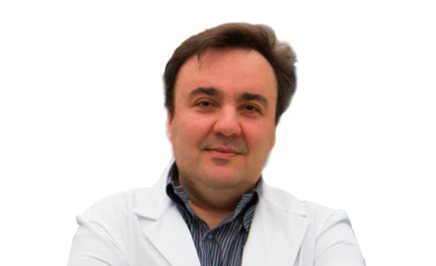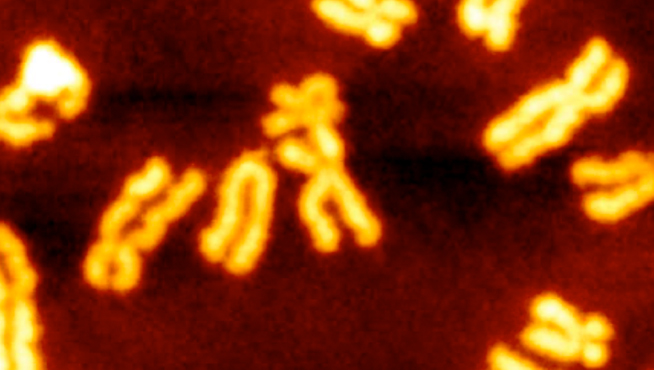Vincenzo Costanzo Lab

Vincenzo Costanzo
Italian, born in Naples in '73, Vincenzo Costanzo directs the DNA Metabolism research program at IFOM.
In 1998, he graduated in Medicine and Surgery at the University of Naples Federico II. His college years were crucial for laying the foundations of his scientific career. read more

DNA Metabolism
Cells respond to DNA damage and replication stress, by activating a multi-faceted response called DNA damage response. In contrast to lower eukaryotes many genes involved in DNA repair and in DNA damage response are lethal when inactivated in mammalian cells even in the absence of apparent DNA damage.read more
Laboratory location: Milan, Italy
Recent publications
-
RAD51 protects abasic sites to prevent replication fork breakage.
Hanthi YW, Ramirez-Otero MA, Appleby R, De Antoni A, Joudeh L, Sannino V, Waked S, Ardizzoia A, Barra V, Fachinetti D, Pellegrini L, Costanzo V.
Mol Cell. 2024 Aug 22;84(16):3026-3043.e11.
doi: 10.1016/j.molcel.2024.07.004 -
POLθ prevents MRE11-NBS1-CtIP-dependent fork breakage in the absence of BRCA2/RAD51 by filling lagging-strand gaps.
Mann A, Ramirez-Otero MA, De Antoni A, Hanthi YW, Sannino V, Baldi G, Falbo L, Schrempf A, Bernardo S, Loizou J, Costanzo V.
Mol Cell. 2022 Nov 17;82(22):4218-4231.e8.
doi: 10.1016/j.molcel.2022.09.013 -
REV1-Polζ maintains the viability of homologous recombination-deficient cancer cells through mutagenic repair of PRIMPOL-dependent ssDNA gaps.
Taglialatela A, Leuzzi G, Sannino V, Cuella-Martin R, Huang JW, Wu-Baer F, Baer R, Costanzo V, Ciccia A.
Mol Cell. 2021 Oct 7;81(19):4008-4025.e7.
doi: 10.1016/j.molcel.2021.08.016. -
SSRP1-mediated histone H1 eviction promotes replication origin assembly and accelerated development.
Falbo L, Raspelli E, Romeo F, Fiorani S, Pezzimenti F, Casagrande F, Costa I, Parazzoli D, Costanzo V.
Nat Commun. 2020 Mar 12;11(1):1345.
doi: 10.1038/s41467-020-15180-5 -
ATR expands embryonic stem cell fate potential in response to replication stress.
Atashpaz S, Samadi Shams S, Gonzalez JM, Sebestyén E, Arghavanifard N, Gnocchi A, Albers E, Minardi S, Faga G, Soffientini P, Allievi E, Cancila V, Bachi A, Fernández-Capetillo Ó, Tripodo C, Ferrari F, López-Contreras AJ, Costanzo V.
Elife. 2020 Mar 12;9:e54756.
doi: 10.7554/eLife.54756
Group members
Staff Scientist
- Anna De Antoni
Technician
- Federica Pezzimenti
Post doc
- Romain Charton
- Christelle El Kai
- Lucia Falbo
- Andrea Gnocchi
- Yodharaudshani Wijesekarahanthi
PhD student
- Alessandra Ardizzoia
- Cristina Castellan
- Andrea Martinez Marroquin
- Rajagopal Papagudi
- Lorenzo Sassi
- Salli Waked
Physician PhD Student
- Beatrice Conti
Press releases
Vincenzo Costanzo Elected EMBO Member
2024.07.10
PROTEOMICS SHEDS LIGHT ON DNA'S “DARK MATTER”
2016.05.06
Microcephaly: here is a protein that regulates brain development
2015.07.16
Two million dollars for science from the Armenise-Harvard Foundation
April 8, 2013
In the press
Nobel Chimica: esperti, da studi nuovo approccio contro il cancro
AGI
2015.10.08
La Molecola che si ripara da sola
Radio3Scienza
2015.10.08 | URL
Il Nobel ai meccanici del DNA
Il Messaggero
2015.10.08 | Carla Massi
L'origine della Microcefalia
Italiasalute
2015.07.22
Microcefalia: ecco la proteina che regola lo sviluppo del cervello
Adnkronos
2015.07.21